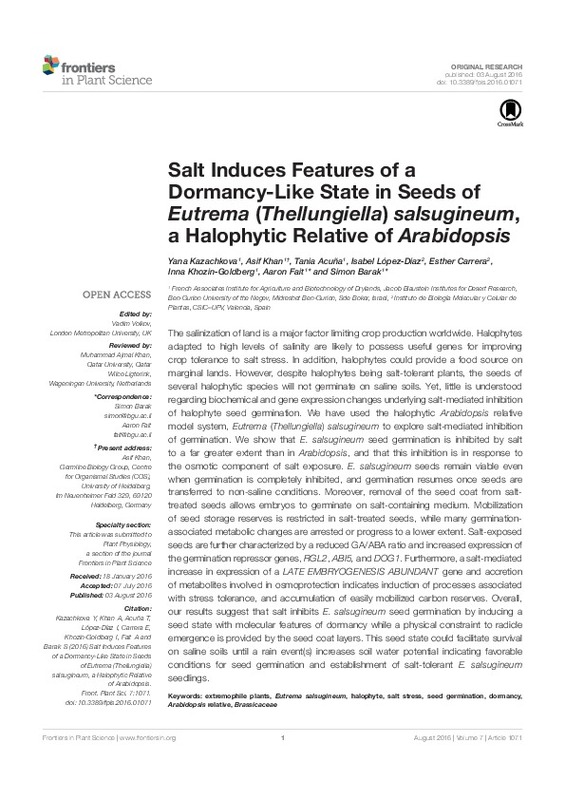JavaScript is disabled for your browser. Some features of this site may not work without it.
Buscar en RiuNet
Listar
Mi cuenta
Estadísticas
Ayuda RiuNet
Admin. UPV
Salt Induces Features of a Dormancy-Like State in Seeds of Eutrema (Thellungiella) salsugineum, a Halophytic Relative of Arabidopsis
Mostrar el registro completo del ítem
Kazachkova, Y.; Khan, A.; Acuña, T.; Lopez Diaz, I.; Carrera Bergua, E.; Khozin-Goldberg, I.; Fait, A.... (2016). Salt Induces Features of a Dormancy-Like State in Seeds of Eutrema (Thellungiella) salsugineum, a Halophytic Relative of Arabidopsis. Frontiers in Plant Science. 7(1071):1-18. https://doi.org/10.3389/fpls.2016.01071
Por favor, use este identificador para citar o enlazar este ítem: http://hdl.handle.net/10251/81238
Ficheros en el ítem
Metadatos del ítem
| Título: | Salt Induces Features of a Dormancy-Like State in Seeds of Eutrema (Thellungiella) salsugineum, a Halophytic Relative of Arabidopsis | |
| Autor: | Kazachkova, Yana Khan, Asif Acuña, Tania Lopez Diaz, Isabel Carrera Bergua, Esther Khozin-Goldberg, Inna Fait, Aaron Barak, Simon | |
| Entidad UPV: |
|
|
| Fecha difusión: |
|
|
| Resumen: |
[EN] The salinization of land is a major factor limiting crop production worldwide. Halophytes adapted to high levels of salinity are likely to possess useful genes for improving crop tolerance to salt stress. In addition, ...[+]
|
|
| Palabras clave: |
|
|
| Derechos de uso: | Reconocimiento (by) | |
| Fuente: |
|
|
| DOI: |
|
|
| Editorial: |
|
|
| Versión del editor: | http://dx.doi.org/10.3389/fpls.2016.01071 | |
| Código del Proyecto: |
|
|
| Agradecimientos: |
We would like to thank Ruti Shaked, and Noga Sikron for excellent technical help. This work was supported by the I-CORE Program of the Planning and Budgeting Committee and The Israel Science Foundation (grant no. 152/11 ...[+]
|
|
| Tipo: |
|








